| |
The London Monarchs were a professional American football team in NFL Europe and its predecessor
league, the World League of American Football (WLAF). The Monarchs played their final season in 1998 as the England
Monarchs. In 1999, they were replaced by the new Berlin Thunder. Early years The WLAF operated in 1991 and 1992 and included six U.S.
teams, one Canadian team, and three European-based teams, including the Monarchs, that was organised in three divisions (North
American West, North American East, and European Divisions). The WLAF suspended operations prior to the 1993 season, but was
revived in 1995 as the World League, featuring six European-based teams, again including the Monarchs. The World League was
renamed "NFL Europe League" in 1998. This league plays its games in the spring so as not to conflict with the traditional
American football season of autumn and early winter. In 1991 and 1992 the Monarchs played their home
games at the famed Wembley Stadium. In the 1991 season the team won the first World Bowl at Wembley, beating the Barcelona
Dragons 21-0, the only team to have beaten them in the entire season. In the first season of the World League, crowds at Wembley
averaged 40,483 for the five games. However dwindling interest - even with the advent of a new local rivalry with the Scottish
Claymores - forced the team to shift its home ground to White Hart Lane, home of Tottenham Hotspur F.C., when the league resumed
play in 1995, and that year average attendance fell to 16,343. Because the pitch at White Hart Lane is
laid out for association football, special dispensation had to be applied for to use a shortened field and it was granted:
the pitch at White Hart Lane measured 93 yards. In 1996, the Monarchs were forced to find an alternative venue for their final
home game and chose Stamford Bridge, where they would play all of their home games in 1997. England MonarchsTowards the end of the 1997 season,
the WLAF was starting to re-evaluate the team's situation in its market, believing that the return to London had not been
as big a success as hoped. In conjunction with general manager Alton Byrd, the team was rebranded the England Monarchs
and travelled the country, playing home games at the Crystal Palace National Sports Centre in London, Ashton Gate (home of
Bristol City F.C.) and Alexander Stadium, an athletics stadium in Birmingham - another step down in the size and quality of
the stadiums used. This venture divided opinion dramatically amongst the Monarchs support and rather than increase interest
in the team, attendances slumped to an average of 5,944. The announcement at the end of the 1998 season that the league would
add a new team, the Berlin Thunder, led to weeks of speculation that either one of the existing teams would be shut down,
or that the Monarchs and Claymores would be amalgamated into a single British team. Confirmation that the Monarchs were to
close down came in July that year. Like other WLAF/NFL Europe teams, most of the Monarchs' players were
young American "developmental" players assigned from teams in the National Football League. The league paid these
players' salaries, as well of that of the coaches, who tended also to be Americans, though there were exceptions - in the
early Monarchs Walter McKone, D.O. was a team osteopath and Stewart Parkinson a team manager. A few players of European extraction
also participated, primarily as kicking specialists, although league rules required the participation of at least one player
of European extraction on every other series of four downs. The league's points leader in 1991 was Phil Alexander, kicker
with the Monarchs, who is currently Managing Director of Crystal Palace football club. One exception to the "kicker phenomenon"
was Victor Ebubedike (later Victor X Ebubedike, and later still Victor Muhammad) who played as running back for the Monarchs
for a number of years, and who became the first European to score a touchdown (versus the Orlando Thunder) in 1991. Notable
players for the Monarchs included Stan Gelbaugh, William Perry, Obafemi Ayanbadejo, Steve "Hollywood" Brooks, Tim
Simpson, and Brad Johnson, a quarterback who would go on to win Super Bowl XXXVII with the Tampa Bay Buccaneers. Also of note
was Dedrick Dodge, a special teams maven, who went on to win a number of Super Bowl rings with teams including the Denver
Broncos. Notable British players include Marc 'Big Bird' Cohen, one of the best European WR of his time. He is currently terrorising
defenses for the Coventry Cassidy Jets in the BAFL Premier division and the EFL. www.wikipedia.org
Location: London, England Stadium: Wembley Stadium (63,500) 1991-1992, Stadium
White Hart Lane (25,000) 1995-1996, Stadium Stamford Bridge (30,000) 1997, London Crystal Palace Athletics Arena (23,000),
Bristol Ashton Gate Stadium (20,000), Birmingham Alexander Stadium (15,000) since 1998 in drei Stadion. Owner:
Jon Smith General Manager: Billy Hicks (1991-1992), Gareth Moores (1995-1996), Alton Byrd (1997-1998) Division: European (1991-1992) Seasons: 1991, 1992, 1995-1997 London Monarchs; 1998
England Monarchs Colors: Royal Blue, Gold, Red, White | Year | Record | Pts For | Pts Aga | Playoffs | Head Coach |
|---|
| 1991 | 9-1, (2-0); European Division Champ | 310
| 121 | beat NY/NJ Knights 42-26;
Won World Bowl 1991 vs Barcelona Dragons 21-0 | Larry Kennan | | 1992 | 2-7-1
| 178 | 203 | | Larry Kennan | | 1995 | 4-6 | 174 | 220
| | Bobby Hammond | | 1996 | 4-6 | 161 | 192 | | Bobby
Hammond (0 - 2);
Lionel Taylor (4 - 4) | | 1997 | 4-6 | 116 | 184 | | Lionel
Taylor | | 1998 | 3-7 | 158 | 205 | | Lionel Taylor | | Overall | 26-33-1, (2-0) |
Team History:
On August 3rd 1990, London was awarded the eighth
franchise in the new 12-team World League of American Football, the first major professional sports league to stage regular
season games on two continents. Known as the 'Monarchs', the team's first home was Wembley Stadium, their first general manager
was Billy Hicks and their first player was British running back Victor X Ebubedike, now known as Victor Muhammad. On
March 23rd 1991, in the opening game in World League history, the Monarchs defeated the Frankfurt Galaxy 24-11. Led by coach
Larry Kennan, who had been the offensive co-ordinator of the Indianapolis Colts before coming to the UK, the team marched
to a 9-1 regular season record, drawing an average crowd of over 40,000 to their home games. Among the club's big name players
were QB Stan Gelbaugh, safety Dedrick 'The Blade' Dodge, linebackers Danny Lockett and Marlon 'Space Dog' Brown, defensive
tackle Roy Hart, running back Judd Garrett and receiver Jon Horton. On June 9th 1991, Wembley hosted World Bowl '91,
the league's championship game, and 61,108 partisan fans cheered as London were crowned the World League's first champions,
avenging their only loss of the season by defeating the Barcelona Dragons 21-0. After losing many top players and Kennan
to the NFL before the start of the '92 season, London struggled to a 2-7-1 record under new head coach Ray Willsey, who had
been defensive co-ordinator of the '91 team. The Sacramento Surge won World Bowl '92 in Montreal, beating the Orlando Thunder
21-17. Hicks resigned as GM. In September 1992, the World League suspended operations and announced plans to restructure
the league with an all-European format. Gareth Moores was named as the club's second general manager and the World
League returned in 1995 as a joint venture between the NFL and America's Fox TV with six European teams. Playing their home
games at White Hart Lane - home of Tottenham Hotspur FC - and coached by former NFL running back Bobby Hammond, the Monarchs
finished with a 4-6 record, averaging crowds of 10,400. The Frankfurt Galaxy won World Bowl '95 in Amsterdam, defeating the
hometown Admirals 26-22. The 1996 season was a difficult one for the Monarchs, who began the campaign in a blaze of
publicity following the signing of former Chicago Bears defender William 'Refrigerator' Perry. Hammond was released after
opening the season with two losses but his replacement - offensive co-ordinator Lionel Taylor - steadied the ship as the team
rallied to a 4-6 record. London's attendances rose by 25 per cent.In December 1996, Stamford Bridge, the home of Chelsea FC,
was named as the Monarchs new venue. London had played the final game of 1996 at the stadium and attracted over 11,000 fans.
1997 began with Alton Byrd being appointed as the team's third general manager following the resignation of Moores
in December. Just days later, Muhammad created history when he was named as a London national player for the fifth straight
season - a World League record. However, once again the Monarchs could only manage a 4-6 record as injuries took a heavy toll
particularly at quarterback where five different players were used. Two of the few high points of the difficult season were
a pair of victories over arch rivals the Scottish Claymores. The final game of the 1997 season saw Taylor reappointed
as head coach for the following year. The off-season was a momentous one in the franchise's history with the name being changed
to 'England Monarchs' in October. It was also announced that the team would play at three different home venues in 1998 -
three games at Crystal Palace National Sports Centre (south London), one at Ashton Gate Stadium (Bristol) and another at Alexander
Stadium (Birmingham). Led by QB Stan Gelbaugh, the Monarchs dominated WLAF competition on their way to the 1991 World
Bowl Trophy. Gelbaugh returned to the Monarchs in 1992, but he was unable to find the success he found in 1991. After almost
putting together a perfect season in 1991, London fell to the bottom of the European Division in their second season. The
Monarchs continue to play in the new World League. Team Name:
Previously known as London, the
franchise became 'England' in October 1997. Great Britain's monarchy is a vibrant part of the nation's heritage, and London
is the traditional home of the king and queen. All the members of the royal family are celebrities as well as political and
historical figures. www.hworth.net/nflel/hist_monarchs.html
The Coaches
Larry Kennan (1991)
Larry Kennan (born June 13, 1944 in Pomona, California)
is a former American football coach. He is currently the staff director of the NFL Coaches Association. [edit] Coaching
careerKennan's coaching career began at
his alma mater La Verne in 1966. After a two-year head coaching stint at Garden Grove High School, he resumed his collegiate
coaching career at Colorado in 1969 and then served as the offensive coordinator at UNLV (1973-75) and Southern Methodist
(1976-78). He was named head coach at Lamar University in 1979, where he coached for three years. Kennan joined the professional ranks in 1982 when Tom Flores named him quality control coach
on his Los Angeles Raiders staff. The following year, he was promoted to quarterbacks coach. He remained with the Raiders
for six seasons, before joining the Denver Broncos as the wide receivers coach in 1988. In 1989, Kennan was named the offensive
coordinator of the Indianapolis Colts. After two
seasons, he was named head coach of the London Monarchs of the World League of American Football. That year, he led the Monarchs
to a 9-1 regular season record and captured the inaugural World Bowl title with a 21-0 victory over the Barcelona Dragons.
He returned to the NFL in 1992 when he was named the offensive coordinator and quarterbacks coach of the Seattle Seahawks,
where he remained through the 1994 season. In
1995, he joined Jim Mora’s staff in New Orleans, where he instructed the Saints tight ends for a year before re-joining
the Raiders in 1996. After one season as Oakland's quarterbacks coach, Kennan was hired by Pete Carroll as offensive coordinator
of the New England Patriots. Ray Willsey (1992) Ray
Willsey (born September 30, 1928) was the head football coach at the University of California
from 1964 to 1971. During his tenure he compiled a 40-42-1 record. He was inducted into the
Orange County Sports Hall of Fame in 1993. Willsey was
born in Regina, Saskatchewan, and played defensive back and quarterback at Tustin
High School and Santa Ana College. He played for the California Bears,
helping the Bears win 26-0 against Stanford in 1952. He graduated from the University of California in 1953 with a degree
in business. He played for three years for the Edmonton Eskimos in Canada, but his playing
career was ended by an elbow injury. His first assistant coaching job was at the age of 28 with the Washington
Redskins, then he was an assistant coach at the University of Texas in
the late '50s. His first NFL position was at defensive coordinator with the Saint Louis Cardinals
in 1961, where he went 2-0. After heading the coaching for California from 1964 to 1971, when he resigned, he rejoined the
Cardinals. He moved to the Oakland Raiders in 1977 as backfield coach. In 1988, he served
as head coach of the Los Angeles Cobras during that team's only year of existence in the
Arena Football League, in which his team compiled a 5-6-1 record. He was defensive coach
of the London Monarchs when they won the World League title in 1991, and he became their
head coach in 1992. He was defensive coordinator for the Scottish Claymores in the mid-90s,
and became director of personnel for NFL Europe in 1996. He was awarded the Glenn T. Seaborg
Award in 2002.
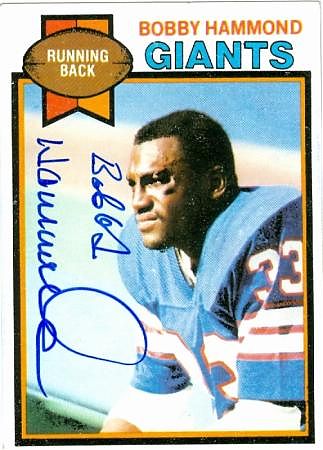 Bobby Hammond (1995 - 1996)
Robert Lee Hammond (born February 20, 1952 in Orangeburg, South
Carolina) is a former American football running back in the National Football League for the New York Giants and the Washington
Redskins. He played college football at Morgan State University. Hammond played high school football at Bayside High School
in Bayside, New York. | Date of birth: | February 20, 1952 (1952-02-20)
(age 58) | | Place of birth: | Orangeburg,
South Carolina | | Career information |
|---|
| Position(s): | Running back | | Jersey №: | 33, 34 | | College: | Morgan State | | Organizations |
|---|
| As player: | 1976-1979
1979-1980 | New York Giants
Washington Redskins | | Playing stats at NFL.com |
|---|
October 25, 1994
Bobby Hammond, an assistant coach
with the Philadelphia Eagles, is named head coach of the London Monarchs.
After the second
straight loss in the 1996 season, Bobby Hammond was fired and Lionel Taylor was hired as head coach.
Lionel Taylor (1996-1998) Lionel Thomas Taylor (born August
15, 1935, in Kansas City, Missouri) is an American former collegiate and Professional Football wide receiver
who led the American Football League (AFL) in receptions each year for the first six years of the league's existence. College footballTaylor attended New Mexico Highlands University, where he had starred in
basketball and track, earning all-conference wide receiver honors in 1956 and 1957. Professional
footballTaylor first played eight games with the Chicago Bears of the National Football League(NFL) before
moving to the Denver Broncos of the AFL for the 1960 season. Second in all-time receptions (543) for the Denver Broncos and
their all-time leading receiver in yardage (6,872), Taylor was the Broncos' team MVP in 1963, 1964 and 1965, and an AFL All-Star
in 1960, 1961, 1962 and 1965. Taylor was the first professional football receiver ever to make 100 catches in a single
season, accomplishing the feat in only 14 games (1961). He had four seasons with over 1,000 yards receiving, and averaged
84.7 catches per year from 1960 to 1965, then the highest six-year total in professional football history.
Taylor completed his career with the Houston Oilers in 1967 and 1968. Professional
Coaching Taylor was on the Pittsburgh
Steelers’ staff in the mid-1970s as a part of two Super Bowl winners By the late ’70s, Taylor was offensive coordinator
for the Los Angeles Rams, while Chuck Noll’s Steelers had procured a former college quarterback was trying to make the
conversion to pro safety. That young player’s name? Tony Dungy. Taylor was the Rams’
offensive coordinator in Super Bowl XIV, but two years later, he was dismissed, having never had the chance to interview for
an NFL head-coaching position. Eventually, Taylor would become a pro head coach … but had
to do so across the Atlantic Ocean, for the England Monarchs of NFL Europe. Nevertheless, his sideline legacy became clear
late Sunday night … and it’s one at least as noteworthy as the on-field kudos he earned with the Broncos in becoming
the franchise’s leading receiver and establishing standards that wouldn’t be surpassed for three decades. http://blog.denverbroncos.com/tag/lionel-taylor/ & www.wikipedia.org Old Wembley Stadium (1991-1992) The original Wembley Stadium, known as the Empire Stadium, was a football
stadium in Wembley, a suburb of north-west London, standing on the site
now occupied by the new Wembley Stadium that opened in 2007.
White Hart Lane (1995-1996)
White Hart Lane is an all-seater football stadium in Tottenham,
London, England. Built in 1899, it is the home of Tottenham Hotspur and, after numerous renovations, the stadium has a capacity
of 36,310. Along with housing Tottenham, the stadium
has also been selected for England national football matches and England under-21 football matches. White Hart Lane held capacity
records in the early 1960s with numbers entering the 70,000s but as seating increased in popularity, the stadium has leveled
out to a modest number in relation to other Premier League clubs. The record attendance remains an FA Cup tie on the 5th March
1938 against Sunderland with the attendance being recorded at 75,038. 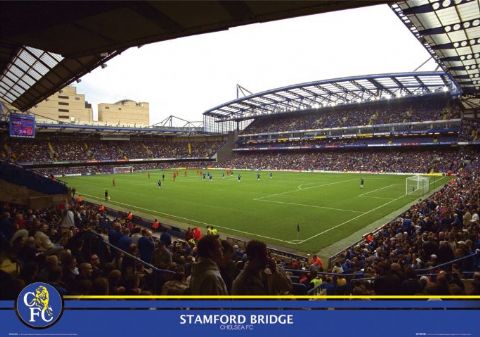 Stamford Bridge (1997)
Stamford Bridge is a football stadium in Fulham, in the
London Borough of Hammersmith and Fulham, west London, that is home to Chelsea Football Club. The stadium is located within
the Moore Park Estate also known as Walham Green. It is nicknamed "The Bridge" by the club's supporters. The capacity
is 41,841, making it the seventh largest ground in the Premier League and the smallest amongst the so-called big four
clubs. KSS Design Group (architects) designed the complete redevelopment of Stamford Bridge Stadium and its hotels, megastore,
offices and residential buildings. 1991 Monarchs Uniform
The 1991 London Monarchs uniform was made by Wilson (pants and jerseys).
The helmets were made by Riddell, gold with a red crown logo and blue Kra-Lite facemasks. Shoes were by Pony.
The home jersey was royal blue with red and tan accents like the striping on the sleeves and the numbering. The away
jerseys were white with the same striping on the sleeves. The numbers were blue with red outlines. Pants stayed the
same for home and away being gold with red and blue stripes down the sides with a WLAF patch in the center. Socks were white
with the top being red, blue and tan colors.
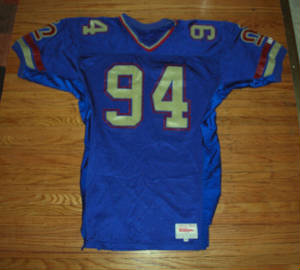
|
| 1991 Monrachs Game Used Home Jersey #94 Danny Lockett OLB |
|
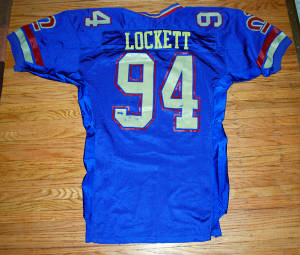
|
| Lockett Jersey (back) |
|
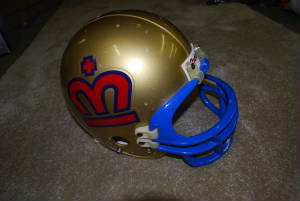
|
| 1991 Monarchs Game Used Riddell VSR-1 Helmet with Kra-Lite Facemask |
|
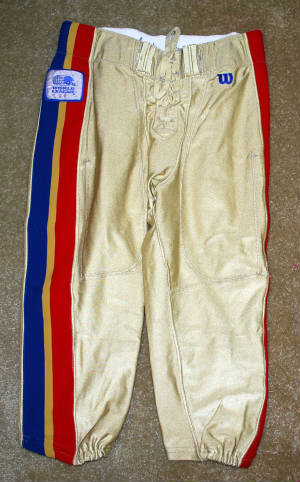
|
| 1991 Monarchs Game Used Pants #64 John Fruhmorgen C |
|
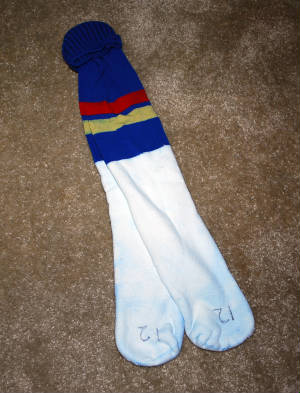
|
| 1991 Monarchs Game Used Socks #12 John Witkowski QB |
|
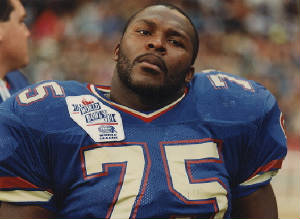
|
| 1991 World Bowl Jersey (with World Bowl Patch) |
|
The 1992 London Monarchs uniform was the same as the 1991 one except the helmets
had WLAF logo stickers on the back (some even had another blue sticker with a warning label) and some of the away jerseys
had a slit where the neck stripes came together (might be all away ones?).
|
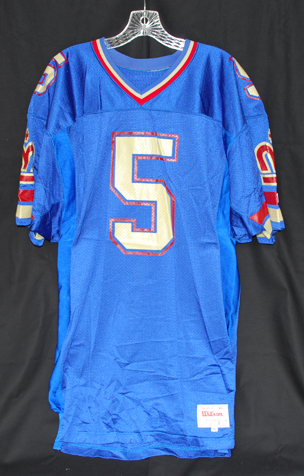
|
| 1992 Monarchs Game Used Home Jersey #5 Fred McNair QB (signed) |
|
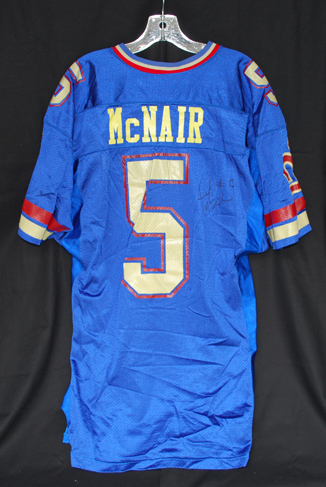
|
| Fred McNair #5 (back) |
|
The 1995 London Monarchs uniform was made by Reebok (Fab Knit was the manufacturer). The uniform was totally
different from what was seen in 1991-1992. The colors remained but now they were more colorful. The home jersey
was a brighter blue with a large red cross (St. George's Cross of England) with a large crown logo, complete with shadow, on
the front of the jersey. The logo was also on the sleeves with the team name underneath. The only instances of
the goldish-tan color are now outlines of the crown. The WLAF logo patch was on the left chest (half on the chest and
half on the shoulder) with the Reebok logo patch on the right. The away jersey was basically white with red shoulders and
a blue rectangular outline on the front and back. There was also a vertical tan section going up the front of the jersey.
The home pants were gold with the blue and red stripe on the sides but without the gold stripe up the middle like before.
The Reebok logo was on the right thigh. On the right hip on top of the striping was the WLAF patch. The other
side was the Monarchs logo patch. The away pants were white with a tan, red and blue stripe down the sides. The Monarchs
logo was more on the front thigh on the left side with the WLAF logo on the right near the Reebok logo. Socks were
white with a royal blue top. Footwear was by Reebok. Helmets were still made by Riddell except they did not have
the plastic facemasks anymore. The back of the helmet has a small WLAF logo sticker.
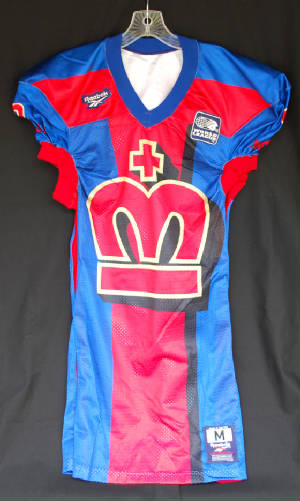
|
| 1995 Unused Reebok Home Jersey |
|
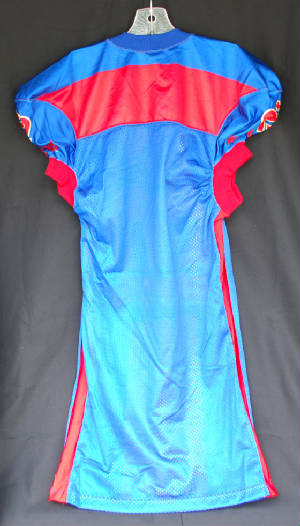
|
| 1995 Unused Reebok Home Jersey (back) |
|
|
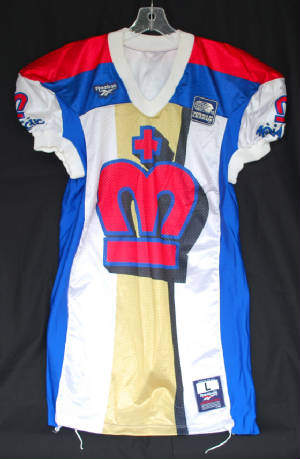
|
| 1995 Unused Reebok Away Jersey |
|
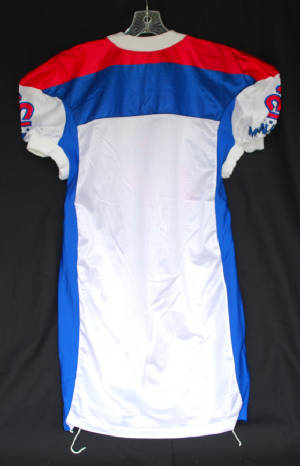
|
| 1995 Unused Reebok Away Jersey (back) |
|
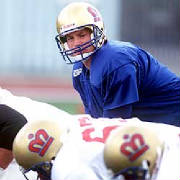
|
| Brad Johnson 1995 Practice Jersey |
|
1996 Monarchs Uniform
The 1996 London Monarchs uniform was exactly the same as the 1995 one except for two tiny details.
The Reebok logo moved from the right front to the left side without the word "Reebok". The WLAF patch was
on the same side as before but now it was below the shoulder stitching.
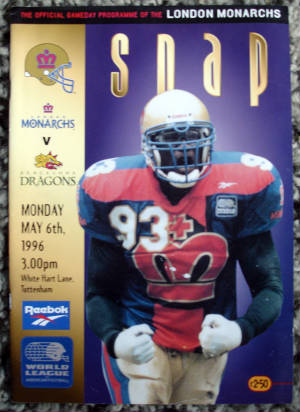
|
| Monarchs Gameday (May 6, 1996) |
|
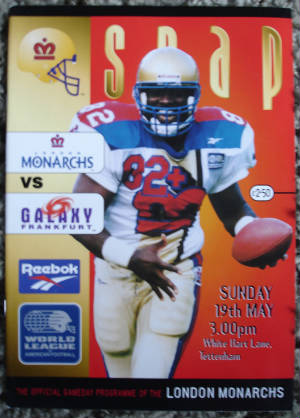
|
| Monarchs Gameday (May 19, 1996) |
|
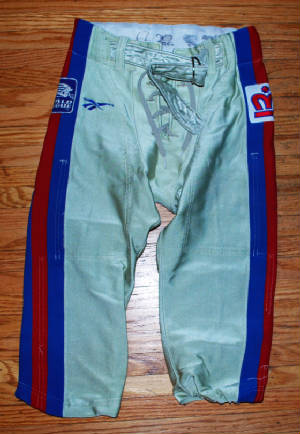
|
| 1996 Monarchs Pants |
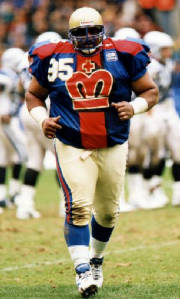
|
| William "The Refrigerator" Perry |
1997 Monarchs Uniform
The 1997 London Monarchs uniform seemed to be a retro version of the old teams. The jersey was pretty
much the 1991-1992 jersey except this time the numbering was stiched on and not silk screened being gold with a red outline.
Fab Knit continued to make the uniform and this is the first time we see their logo on the left upper chest area. The
WLAF patch was small and at the base of the neckline. The pants were gold with red and blue stripes down the sides. Socks
were white and blue.
More Monarchs History
LONDON MONARCHS Based: Wembley
Stadium, London (1991-1992), White Hart Lane, Tottenham, London (1995-1996), Stamford Bridge, Chelsea, London (1997)
Career
Record: 25-26-1
Colours: Gold pants/White shirts with blue numbers/Gold helmets
Website: www.londonmonarchs.co.uk (unofficial)
Honours: World Bowl I winners 1997
WLAF 4-6-0
1996 WLAF 4-6-0
1995 WLAF 4-6-0
1992 WLAF European Division 2-7-1
1991 WLAF European Division
9-1-0* Team Notes: On August 3rd 1990, London was awarded the eighth franchise in the new
12-team World League of American Football, the first major professional sports league to stage regular season games on two
continents. Known as the 'Monarchs', the team's first home was Wembley Stadium, their first general manager was Billy Hicks
and their first player was British running back Victor X Ebubedike, now known as Victor Muhammad. On March 23rd 1991, in the
opening game in World League history, the Monarchs defeated the Frankfurt Galaxy 24-11. Led by coach Larry Kennan, who had
been the offensive co-ordinator of the Indianapolis Colts before coming to the UK, the team marched to a 9-1 regular season
record, drawing an average crowd of over 40,000 to their home games. Among the club's big name players were QB Stan Gelbaugh,
safety Dedrick 'The Blade' Dodge, linebackers Danny Lockett and Marlon 'Space Dog' Brown, defensive tackle Roy Hart, running
back Judd Garrett and receiver Jon Horton. On June 9th 1991, Wembley hosted World Bowl '91, the league's championship game,
and 61,108 partisan fans cheered as London were crowned the World League's first champions, avenging their only loss of the
season by defeating the Barcelona Dragons 21-0. During that first season, the English kicker Phil Alexander kicked 8 of 13
field-goals and added 37 extra points to be voted kicker and Operation Discovery player on the All-World League First Team.
Ebubedike rushed for 64 yards and 1 touchdown on 12 carries and chipped in with 16 special teams tackles to be named the Operation
Discovery player on the All-World League Second Team. After losing many top players and Kennan to the NFL before the start
of the '92 season, London struggled to a 2-7-1 record under new head coach Ray Willsey, who had been defensive co-ordinator
of the '91 team. The Sacramento Surge won World Bowl '92 in Montreal, beating the Orlando Thunder 21-17. Hicks resigned as
GM. In September 1992, the World League suspended operations and announced plans to restructure the league with an all-European
format. Gareth Moores was named as the club's second general manager and the World League returned in 1995 as a joint venture
between the NFL and America's Fox TV with six European teams. Playing their home games at White Hart Lane - home of Tottenham
Hotspur FC - and coached by former NFL running back Bobby Hammond, the Monarchs finished with a 4-6 record, averaging crowds
of 10,400. The Frankfurt Galaxy won World Bowl '95 in Amsterdam, defeating the hometown Admirals 26-22. The 1996 season was a difficult one for the Monarchs, who began the campaign in a blaze of publicity
following the signing of former Chicago Bears defender William 'Refrigerator' Perry. Hammond was released after opening the
season with two losses but his replacement - offensive co-ordinator Lionel Taylor - steadied the ship as the team rallied
to a 4-6 record. London's attendances rose by 25 per cent.In December 1996, Stamford Bridge, the home of Chelsea FC, was named
as the Monarchs new venue. London had played the final game of 1996 at the stadium and attracted over 11,000 fans. 1997 began
with Alton Byrd being appointed as the team's third general manager following the resignation of Moores in December. Just
days later, Muhammad created history when he was named as a London national player for the fifth straight season - a World
League record. However, once again the Monarchs could only manage a 4-6 record as injuries took a heavy toll particularly
at quarterback where five different players were used. Two of the few high points of the difficult season were a pair of victories
over arch rivals the Scottish Claymores. The final game of the 1997 season saw Taylor reappointed as head coach for the following
year. The off-season was a momentous one in the franchise's history with the name being changed to 'England Monarchs' in October.
It was also announced that the team would play at three different home venues in 1998 - three games at Crystal Palace National
Sports Centre (south London), one at Ashton Gate Stadium (Bristol) and another at Alexander Stadium (Birmingham). Led by QB
Stan Gelbaugh, the Monarchs dominated WLAF competition on their way to the 1991 World Bowl Trophy. Gelbaugh returned to the
Monarchs in 1992, but he was unable to find the success he found in 1991. After almost putting together a perfect season in
1991, London fell to the bottom of the European Division in their second season. In 1998 they became known as the English
Monarchs, but at the end of that season the Monarchs were withdrawn as a NFL Europe side and the Berlin Thunder took their
place. Victor Muhammad, who had spent all six seasons with the Monarchs before retiring after the 1998 campaign compiled career
figures of 116 carries for 416 yards and 4 touchdowns. http://www.britballnow.co.uk/History/Britball%20Teams/LONDONMONARCHS.htm
TriviaThe London Monarchs and the Birmingham Fire were the first
two teams in WLAF/NFL Europe history to end a game in a tie (17-17 in Week 4 of the '92 season). The Berlin Thunder, the team
that replaced London in the league in 1999, and Hamburg Sea Devils (who replaced the Scottish Claymores in 2005) repeated
not only the feat of a tied game, but also the exact same score, on April
1, 2006 of all days.
Notable MonarchsPhil Alexander (K, 1991-2) Marc
'Big Bird' Cohen (WR, 1995) Clive Allen (K, 1995) Victor Ebubedike, aka Victor Muhammad (RB) Stan Gelbaugh (QB, 1991-2) Jon Horton (WR) Brad Johnson (QB, 1996) William Perry (DT, 1996)
Don Silvestri (K) Rob Hart (1998)
1. 42 FS Harvey Wilson College Southern 2. 22 RB Judd Garrett College Princeton 3.
33 FS Dedrick Dodge College Florida State. Dodge later played in the NFL for six seasons with four different teams. first
with the Seattle Seahawks from 1991 to 1992 then San Francisco 49ers from 1994 to 1996 and finally a season each with the
Denver Broncos and San Diego Chargers 1997 and 1998 respectively. 1. 20 FB Jeff Alexander College Southern Alexander later played two years in the NFL with the Denver Broncos played in 14 games in 1989 and later 7 games in
1992.

|
| Victor Ebubedike |
Mr. Monarchs! Victor Ebubedike (aka Victor X Ebubedike aka Victor
Muhammed) was the only player to play for the Monarchs from 1991 to 1998 (the entire history of the team!).
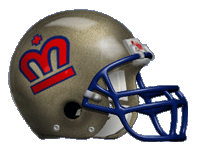
|
| 1991 Results, Stats, Roster |
|

|
| 1992 Results, Stats, Roster |
|

|
| 1995 Results, Stats, Roster |
|

|
| 1996 Results, Stats, Roster |
|

|
| 1997 Results, Stats, Roster |
|
|
|